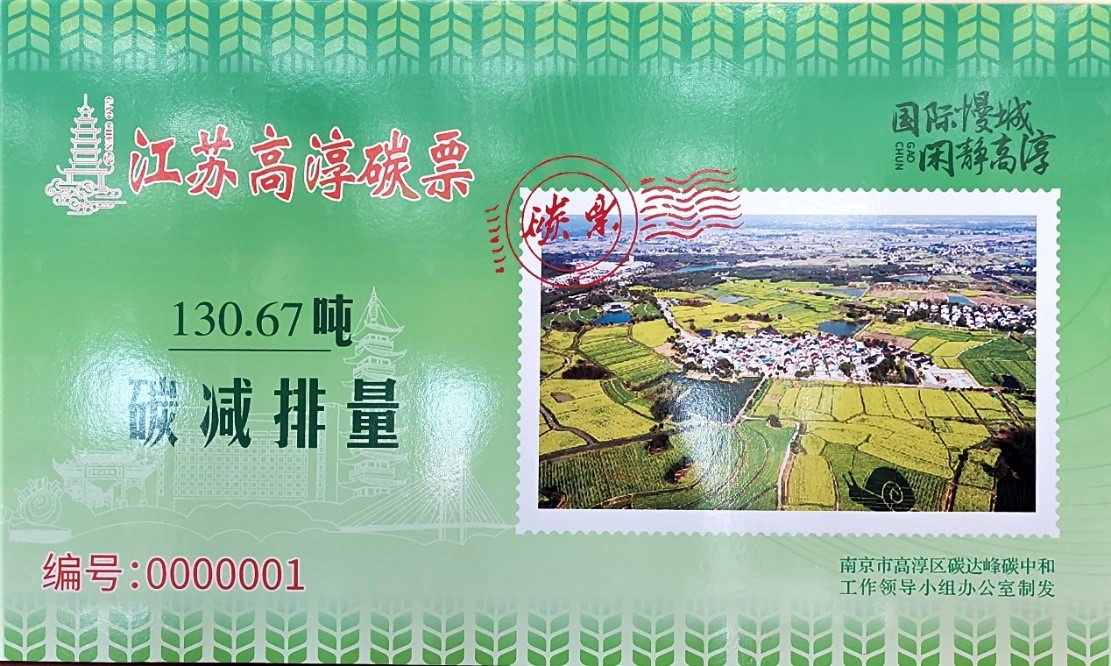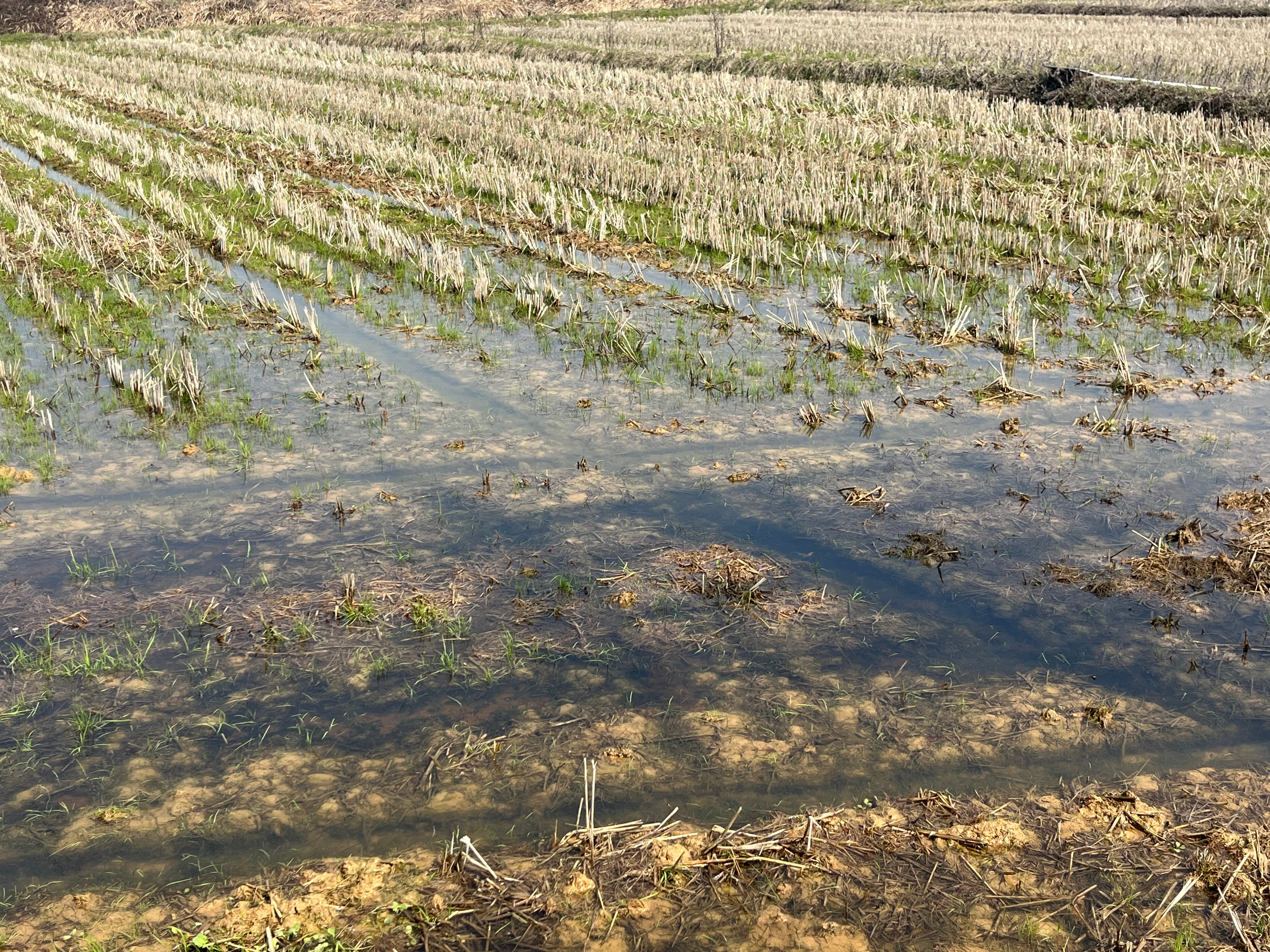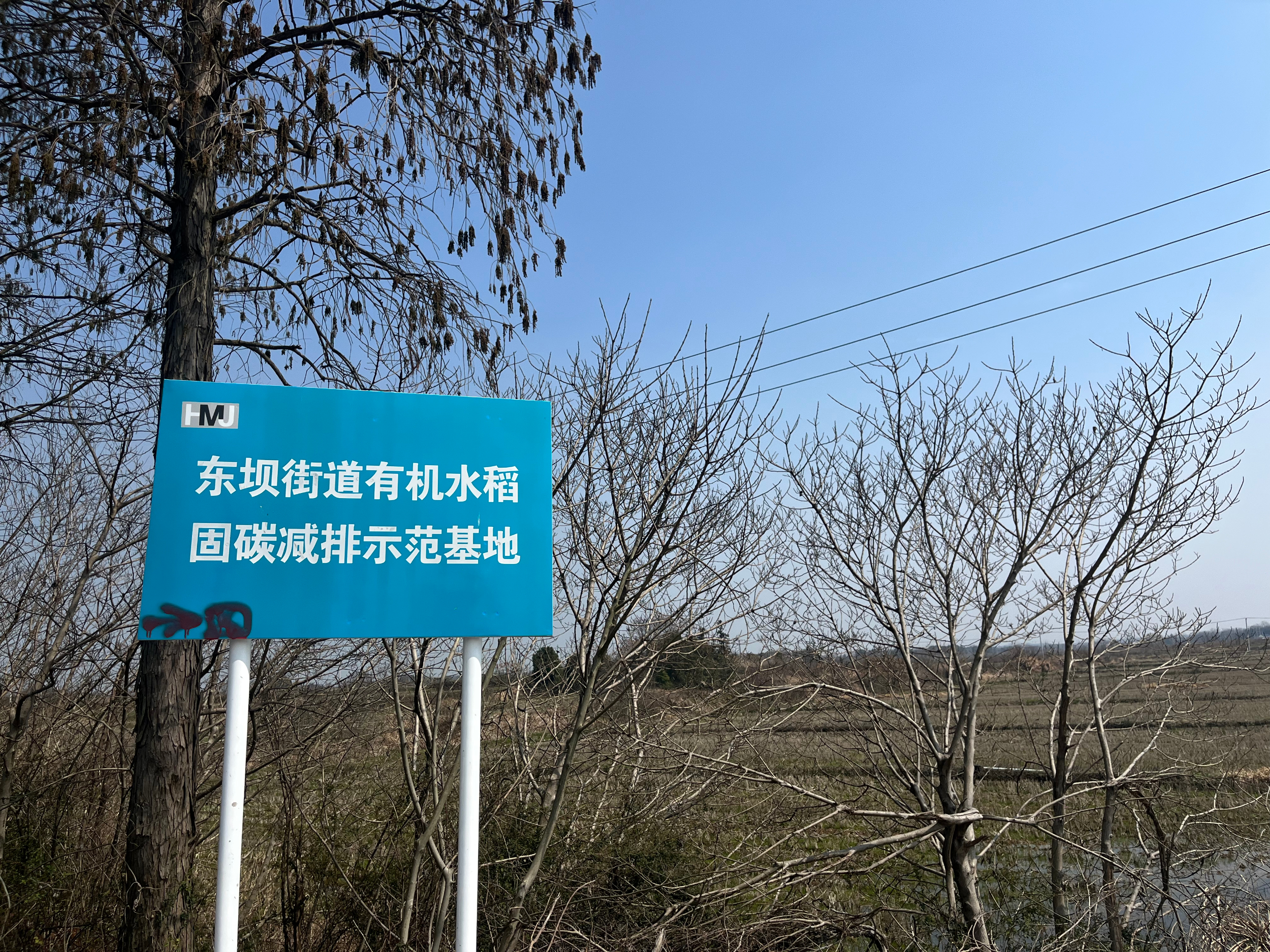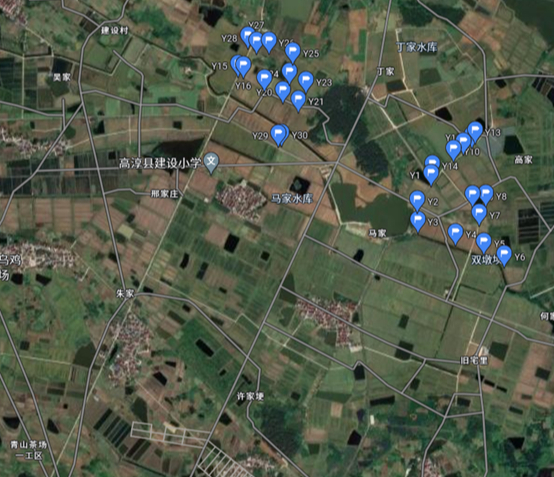In 500 acres of rice fields, carry out a biochar emission reduction experiment
At the beginning of March, a numbered 0000001 carbon ticket was signed out in Gaochun District, Nanjing City, Jiangsu Province, and 130.67 tons of carbon emission reduction was auctioned by Hongbaoli Group, which is the "first shot" of carbon sink generated by biochar organic rice in China, and it is also an important exploration of voluntary greenhouse gas emission reduction trading in Jiangsu Province.
More than 100 tons of carbon sinks were auctioned from 500 acres of rice fields in the Chunhe Rice Professional Cooperative in Hemujian Village, Gaochun District. From the moment the rice entered the field in 2022, a farmland carbon sequestration and emission reduction experiment led by the Nanjing Institute of Environmental Sciences of the Ministry of Ecology and Environment was launched.

The first carbon ticket in Gaochun District, Nanjing City, Jiangsu Province. Image source: Courtesy of the interviewee
agricultureFacing the important task of reducing emissions and increasing sinks, biochar is used to reduce carbon emissions from paddy fields
In March, the paddy fields were still bare. Last year's rice has been harvested, and the new crop has not yet been planted. The black "water ditches" criss-cross the rice fields and are clearly visible. But the black color does not come from sludge, but from biochar that is placed in the field.

At the bottom of the paddy field is black biocharcoal. Photo by Ren Jing
"Biochar is formed by high-temperature carbonization of straw, which can not only sequester carbon, but also improve the soil. Guo Ruqing, Rural Environment and Organic Food Development Research Center, Nanjing Institute of Environmental Sciences, Ministry of Ecology and Environment, introduced the advantages of biochar application in agriculture to reporters.
Why use biochar in the process of planting organic rice? This should start from rice planting - organic fertilizer instead of chemical fertilizer can effectively reduce agricultural non-point source pollution, but organic fertilizer is easy to ferment in water to form methane, and the greenhouse effect of methane is 27.9 times that of carbon dioxide, which is very unfavorable to China's greenhouse gas emission reduction performance.
As the world's largest rice producer and rice consumer, China emits about 5 million to 8 million tons of methane from paddy fields every year. As early as May 2022, the Ministry of Agriculture and Rural Affairs and the National Development and Reform Commission jointly issued the "Implementation Plan for Agricultural and Rural Carbon Emission Reduction and Sequestration", which has placed methane emission reduction in paddy fields at the top of the top ten actions, which means that agriculture is also facing the heavy task of reducing emissions and increasing sinks.
Biomass charcoal is undoubtedly a good helper. The inert structure of biochar ensures that the fixed carbon will remain in the soil for a long time and cannot participate in the atmospheric cycle again, effectively reducing the carbon emissions of rice fields. At the same time, biochar can improve the soil and reduce the pests and diseases such as sheath blight and borer brought by straw returning to the field.
However, in China, almost no one uses biochar for organic rice cultivation, how much is invested per mu of rice field, and what is the relationship between the amount of input and emission reduction...... These thorny issues need to be addressed urgently. To this end, the Nanjing Institute of Environmental Sciences of the Ministry of Ecology and Environment, together with the College of Resources and Environmental Sciences of Nanjing Agricultural University and Nanjing Guohuan Organic Product Certification Center Co., Ltd., set up a project team to select 500 acres of rice fields as experimental fields in Chunhe Rice Professional Cooperative in Hemujian Village, Gaochun District, Nanjing City, to build a demonstration base for carbon sequestration and emission reduction of organic rice.

There is a sign on the edge of the rice field that reads "Dongba Street Organic Rice Carbon Sequestration and Emission Reduction Demonstration Base". Photo by Ren Jing.
"The reason why I chose Hemujian Village is because it has a 15-year history of organic rice cultivation, with a planting scale of 2,600 acres, and all agricultural records are complete, which is convenient for experiments. Guo Ruqing told reporters. An experiment to reduce emissions from biochar for rice cultivation has begun.
500 acres of rice test field, withBiomass charcoalThe carbon sequestration reached 130.67 tons
In order to select a suitable test field, the staff of the project team spent a lot of effort.
Through field investigations, the staff comprehensively considered the planting characteristics and growth characteristics of organic rice in Hemujian Village, and selected a total of 30 sites and 500 acres of rice fields as experimental fields. They are located in the middle of the village's 2,600 acres of rice fields, and are relatively independent and not easily affected by the surrounding environment.

Schematic diagram of the distribution of 500 acres of paddy fields. Image source: Courtesy of the interviewee
In order to calculate what kind of delivery method can maximize emission reduction, the project team prepared a biochar application plan for a 500-mu demonstration base, and instructed the local agricultural leaders to put 60 tons of biochar into the organic rice carbon sequestration and emission reduction demonstration base according to the zonal gradient method. During the rice planting, they collected 240 soil samples from 30 sites and recorded the latitude and longitude of each site using GPS.
"This is in preparation for the next step in calculating the amount of carbon sequestration to be reduced. Only with accurate data can biochar be proved to have the effect of reducing emissions and sequestering carbon. Zhang Jibing, director of the Rural Environment and Organic Food Development Research Center of the Nanjing Institute of Environmental Sciences of the Ministry of Ecology and Environment, said at the press conference on emission reduction results.
For the whole experiment, it is not the most difficult to select the test site and plant rice, but to calculate the amount of gas emissions and soil carbon sequestration. Because there is no model that can be directly used for reference in China, the staff of the project team can only collect data by consulting Chinese and foreign literature, and record data such as latitude and longitude, soil organic matter content, and green manure application rate during the experiment, and build a database, which took more than a year to build a suitable model.
Finally, it was calculated that by using biochar, the soil organic matter content of 500 mu of organic rice fields increased by 6.1% on average, and the total emission reduction and sequestration of carbon dioxide equivalent was 130.67 tons.
"But it will still take some time for biochar to be widely used in the planting field. Cheng Kun, an associate professor at the College of Resources and Environmental Sciences of Nanjing Agricultural University, believes that there are still shortcomings in the promotion of biochar - the cost of use is too high. The high cost is not because there are technical bottlenecks in its production, but because there are fewer production enterprises, and the production cost and transportation cost are relatively high, resulting in the use cost of 1700-1800 yuan per ton.
Cheng Kun told reporters that the current sales volume of biochar is relatively narrow, because it cannot produce immediate results in the process of its use, resulting in farmers having no motivation to buy. If we want to promote biomass charcoal, we should combine it with carbon sink trading, and increase everyone's enthusiasm for carbon reduction through carbon sink compensation.
Take the first step in agricultural carbon sequestration and transform the value of ecological productsimplementbreakthrough
In Gaochun, the combination of biochar and carbon sink trading has begun.
On the morning of March 8, after four rounds of fierce bidding by three companies, 130.67 tons of carbon sinks generated by 500 acres of paddy fields were auctioned by Hongbaoli Group Co., Ltd., with a transaction price of 75 yuan a ton and a total transaction price of 9800.25 yuan.
Wei Tongtian, head of the Chunhe Rice Professional Cooperative in Hemujian Village, was very happy after the hammer fell, saying that last year, through the application of biocharcoal, the yield of organic rice fields increased by 10%, the sales increased by 1 million yuan, and each member increased by more than 1,700 yuan. This time, the 'sale of air' earned more than 9,000 yuan, and the cooperative's agricultural production funds have been added to it.
Rui Yimin, president of Hongbaoli Group Co., Ltd., told reporters that the carbon sinks from the auction will be used in the construction of new projects to offset the carbon emissions caused by the new production capacity. In the process of gradually growing the scale of enterprises and gradually improving the quality of development, in addition to promoting the transformation of their own production to green and low-carbon, they need the support of external carbon trading, which is also an important part of enterprises to participate in market competition.
This auction is also a new attempt by Gaochun District to trade agricultural carbon sinks. In October last year, the national greenhouse gas voluntary emission reduction trading market (CCER) was reopened, marking the further strengthening of the market-based mechanism of carbon trading. At present, the Ministry of Ecology and Environment has formulated and released four voluntary greenhouse gas emission reduction project methodologies, including afforestation carbon sinks, grid-connected solar thermal power generation, grid-connected offshore wind power generation, and mangrove construction, but agricultural carbon sinks have not been included in the CCER market for the time being. "This paid auction based on the additional carbon sinks generated by the application of biochar on organic rice is an important exploration for Jiangsu's future voluntary greenhouse gas emission reduction trading. Liu Guocai, director of the Nanjing Institute of Environmental Sciences of the Ministry of Ecology and Environment, said at the auction.
"This agricultural carbon sink transaction marks a major breakthrough in the value transformation of ecological products in our region. Hu Xueyi, member of the Standing Committee of the Gaochun District Party Committee and executive deputy mayor, told reporters that in the next step, they will take this opportunity to seize the blank spot in the agricultural carbon sink trading market, take the lead in the trial, actively explore the agricultural carbon sink trading mechanism, and strive to build a demonstration sample for the Yangtze River Delta agricultural carbon sink trading project development and adjustment of the value realization of service ecological products.







